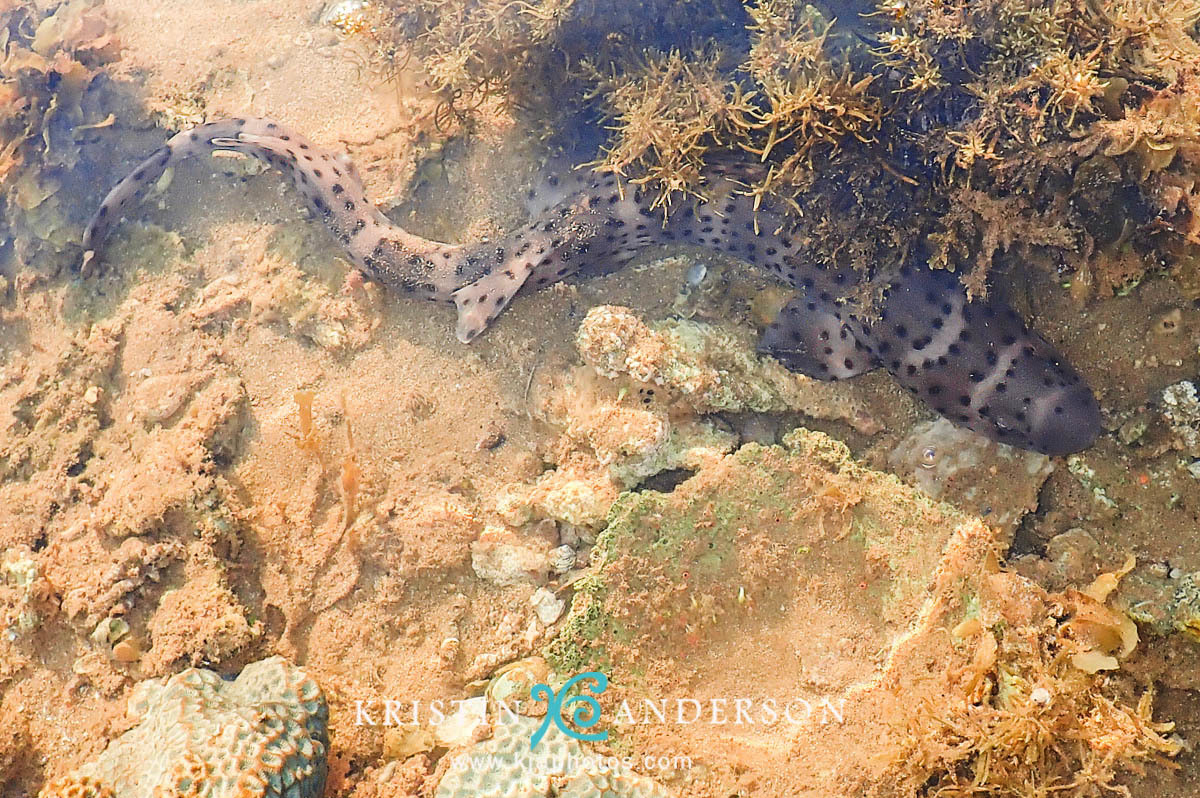Marbled Catshark, Atelomycterus macleayi Whitley 1939
Other Names: Australian Marbled Catshark, Marbled Cat-shark

A Marbled Catshark, Atelomycterus macleayi, at Port Hedland, Western Australia, September 2018. Source: Kristin Anderson / iNaturalist.org. License: CC by Attribution-NonCommercial
Summary:
A slender brown catshark with about seven well-defined greyish saddles before the first dorsal-fin origin, and numerous large black spots and lines. The saddles are separated by pale areas and often outlined by numerous small black spots, although they may be indistinct in densely-spotted individuals.The spots extend ventrally to at least eye level, and all fins are spotted, including undersides of pectoral fins. Newly hatched pups have a simpler pattern of dark saddles.
Cite this page as:
Bray, D.J. 2018, Atelomycterus macleayi in Fishes of Australia, accessed 01 Jul 2025, https://fishesofaustralia.net.au/home/species/1412
Marbled Catshark, Atelomycterus macleayi Whitley 1939
More Info
|
Distribution |
Port Hedland, Western Australia, to Melville Island, Northern Territory. Inhabits shallow, inshore sandy and rocky areas in depths to 80 m. |
|
Features |
Vertebrae total 167-183, precaudal 112-132. Body slender, snout very short, rounded; anterior nasal flaps very large, subrectangular, extending posteriorly to overlap mouth. Upper labial furrows long, level with upper jaw symphysis; lower labial furrows almost joined. Teeth small, tricuspid, with a greatly enlarged central cusp, similar in both jaws. Skin velvety, covered in dense minute denticles; no ridge of enlarged denticles along dorsal caudal-fin margin. First dorsal-fin origin above or slightly behind pelvic-fin insertion; second dorsal-fin origin above or slightly before middle of anal-fin base. Dorsal fins tll, upright, about equal in size, strongly falcate, posterior margins angled forwards, deeply concave (strongly falcate). Anal fin much smaller than second dorsal fin,. Pectoral fins with broadly rounded tips. Caudal fin short, small, ventral length of caudal fin longer than head. Claspers of mature males short, very stout, outer margin length less than 5 times width at base. |
|
Biology |
Oviparous (egg-laying), with males maturing at 48 cm TL, and females at 51 cm TL; young hatch at about 10 cm TL. |
|
Etymology |
The species is named macleayi after William Macleay, a noted naturalist who described many fish species. |
|
Species Citation |
Atelomycterus macleayi Whitley 1939, Aust. Zool. 9(3): 230, fig. 3. Type locality: Port Darwin, Northern Territory. |
|
Author |
Bray, D.J. 2018 |
|
Resources |
Marbled Catshark, Atelomycterus macleayi Whitley 1939
References
Allen, G.R. 1997. Marine Fishes of Tropical Australia and South-east Asia. Perth : Western Australian Museum 292 pp. 106 pls.
Allen, G.R. & Swainston, R. 1988. The Marine Fishes of North-Western Australia. A field guide for anglers and divers. Perth, WA : Western Australian Museum vi 201 pp., 70 pls.
Compagno, L.J.V. 1984. FAO Species Catalogue. Sharks of the World. An annotated and illustrated catalogue of shark species known to date. Carcharhiniformes. FAO Fisheries Synopsis No. 125. Rome : FAO Vol. 4(2) 251-655 pp.
Compagno, L.J.V., Dando, M. & Fowler, S. 2005. A Field Guide to the Sharks of the World. London : Collins 368 pp.
Compagno, L.J.V. & Niem, V.H. 1998. Families Scyliorhinidae, Proscylliidae. pp. 1279-1292 in Carpenter, K.E. & Niem, V.H. (eds). The Living Marine Resources of the Western Central Pacific. FAO Species Identification Guide for Fisheries Purposes. Rome : FAO Vol. 2 687-1396 pp.
Compagno, L.J.V. & Stevens, J.D. 1993. Atelomycterus fasciatus n. sp., a new catshark (Chondrichthyes: Carcharhiniformes: Scyliorhinidae) from tropical Australia. Records of the Australian Museum 45(2): 147-169 DOI:10.3853/j.0067-1975.45.1993.19 Open access
Jacobsen, I P. & Bennett, M.B. 2007. Description of a new species of catshark, Atelomycterus marnkalha n. sp. (Carcharhiniformes: Scyliorhinidae) from north-east Australia. Zootaxa 1520: 19-36.
Larson, H.K., Williams, R.S. & Hammer, M.P. 2013. An annotated checklist of the fishes of the Northern Territory, Australia. Zootaxa 3696(1): 1-293.
Larson, H.K. & Williams, R.S. 1997. Darwin Harbour fishes: a survey and annotated checklist. pp. 339-380 in Hanley, H.R., Caswell, G., Megirian, D. & Larson, H.K. (eds). The Marine Flora and Fauna of Darwin Harbour, Northern Territory, Australia. Proceedings of the Sixth International Marine Biology Workshop. Darwin : Museum and Art Gallery of the Northern Territory 466 pp.
Last, P.R. & Stevens, J.D. 1994. Sharks and Rays of Australia. Canberra : CSIRO Australia 513 pp. 84 pls.
Last, P.R. & Stevens, J.D. 2009. Sharks and Rays of Australia. Collingwood : CSIRO Publishing Australia 2, 550 pp.
McKay, R.J. 1966. Studies on Western Australian sharks and rays of the families Scyliorhinidae, Urolophidae and Torpedinidae. Journal of the Royal Society of Western Australia 49(3): 65-82 figs 1-6 (in part, also as Atelomycterus marmoratus)
Springer, S. 1979 A revision of the catsharks, family Scyliorhinidae. NOAA Technical Report. National Marine Fisheries Service Circular 422: 1-152.
White, W.T. 2015. Atelomycterus macleayi. The IUCN Red List of Threatened Species 2015: e.T41729A68610061. http://dx.doi.org/10.2305/IUCN.UK.2015-4.RLTS.T41729A68610061.en. Downloaded on 14 November 2018.
White, W.T., Last, P.R. & Dharmadi. 2005. Description of a new species of catshark, Atelomycterus baliensis (Carcharhiniformes: Scyliorhinidae) from eastern Indonesia. Cybium 29(1): 33-40. Ref available online, open access
Whitley, G.P. 1932. Studies in Ichthyology No. 6. Record of the Australian Museum 18(6): 321–348 figs 1–3 pls 36–39 (Plate xxxviii, fig. 1. as Atelomycterus marmoratus = holotype of A. macleayi) Ref available online, open access
Whitley, G.P. 1939. Taxonomic notes on sharks and rays. The Australian Zoologist 9(3): 227-262 figs 1-18 pls 20-22 Ref at BHL
Whitley, G.P. 1940. The Fishes of Australia. Part 1. The sharks, rays, devil-fish, and other primitive fishes of Australia and New Zealand. Sydney : Roy. Zool. Soc. N.S.W. 280 pp. 303 figs.





